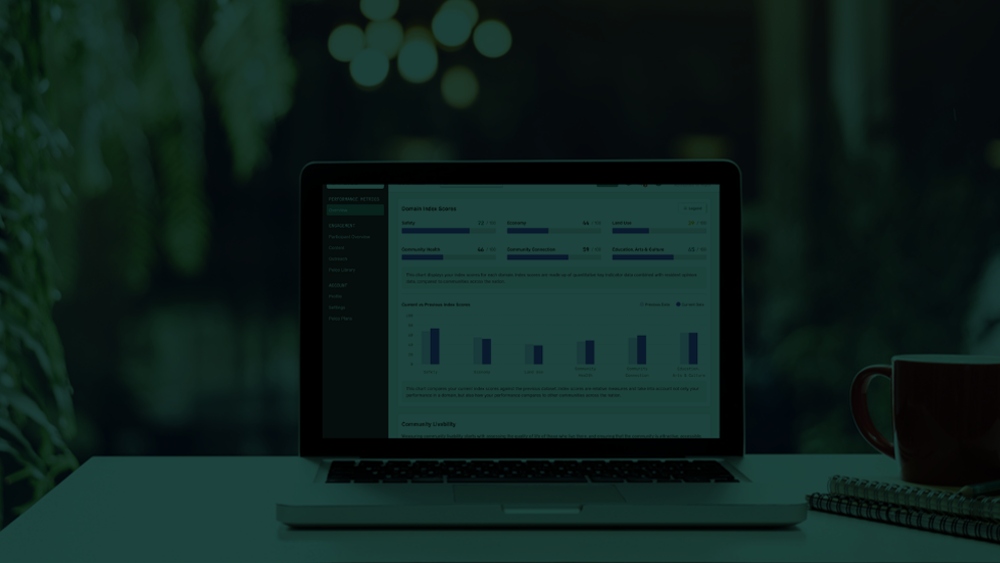How the Government Performance Action & Learning Partnership Empowers Government Decision-makers
By Polco on October 6, 2022

Learn how GPAL synthesizes a mass of public data so government leaders can connect with their communities, better understand quality of life, and make informed decisions.
A cross-industry collaboration, Government Performance Action and Learning (GPAL), has transformed government performance measurement. Polco and academic, government, and private partners amassed a rich database using public information. GPAL synthesizes the public data into easy-to-read indicators on community livability.
“[It’s] performance and sentiment analysis that doesn’t require a bunch of spreadsheets and data entry,” said Jonathan Wiersma, Polco’s Vice President of Marketing.
In this press conference, Wiersma, Michelle Kobayashi, Polco Vice President of Innovation, and Tobin McKearin, Polco Vice President of Data Science, give attendees a closer look at GPAL and its capabilities.

How GPAL Was Born
The origin story started in 1989 when Kobayashi was 22 working in Boulder, Colorado, for National Research Center, which is now Polco’s internal survey research and data science team. She ran Boulder's resident survey to measure quality of life in the city. Kobayashi shared the survey report with city leaders. Certain departments like the library and parks and recreation were excited about the results, while other departments like economic planners and transportation were less than enthused.
It raised some questions. Maybe it’s not fair to expect each component of community livability to score highly. And what do these scores actually mean? Is an 80% positive response rate excellent, average, or even below average?
To understand Boulder's results better, Kobayashi contacted all cities of Colorado to see if they had done a resident survey. Even though she only received 10 responses, it was exhilarating to aggregate the data and come up with comparable benchmarks that would help add context to Boulder's numbers.
The next year, NRC partnered with ICMA to gather resident surveys from around the United States and create a national benchmark database. There were tons of other valuable public data resources, like the census, available that could add even more context to results. But government leaders would have to do that research on their own.
Then, in 2019, NRC merged with Polco.
“It was like Christmas for us in terms of performance measurement, because not only do we get this platform that is great at automating community research and civic engagement, but we got this whole team of data scientists and data engineers,” she said. “ We know there is all this big data that we need to collapse, aggregate, synthesize. And now we have a team.”
The new team, along with GPAL partners, removed the extra legwork by putting all that valuable data together in one place and aligning the indicators with easy-to-evaluate domains that impact community livability.
Why Does GPAL Matter?

Data reveal a sharp decline in government trust since 2020, the biggest decrease in the past 10 years.
“This is showing people are wanting to hold their governments accountable. They want to trust their governments. They want to see transparency. And this need for transparency and accountability is greater than it has ever been before,” McKearin said.
Data is available to provide transparency and reveal how local governments are doing, but it’s difficult to access. Government officials need the resources to be able to retrieve and decipher the overwhelming amount of information. GPAL gives leaders this information in an easy-to-read dashboard.
GPAL can also help governments access federal funds. The American Rescue Plan Act, and the recent infrastructure and climate bills among other funding legislation have pumped unprecedented dollars into the states.
Those funds require governments have data upfront as proof of the need to obtain the dollars. The data is also useful after projects to show that money was put to effective use.
More About the GPAL Partnership
Current partners include National Research Center at Polco, ICMA, University of Wisconsin COWS, performance management software company Envisio, Arizona State University (ASU), and the Hoover Institution at Stanford University. More partners may join in the future.
COWS, in particular, was instrumental in collecting the public datasets.
“All of [these partners] have different strengths,” McKearin said. “Some of us are organizing, some are doing academic regression, some are doing regression analysis, some are getting the word out to the city managers and county managers, some of us are think tanks. So bringing everyone together creates this group is to make GPAL as high-quality as it can be for all the city, county, and other municipality managers and leaders.”
A Deeper Dive Into GPAL
“One of the things that has changed in the last decade, really the past few years, is the prevalence of these data sets,” Kobayashi said. “The power of Polco and our ability to work with these universities, the grad students, and the data science folks is to really be able to harness these data sets.”
Federal agencies release a ton of statistics that have a lot to say, Kobayashi said. But what is difficult is collecting all of the information and finding meaningful indicators—indicators that show how governments are affecting community livability.
But because NRC has studied quality of life through community surveys for the past 30 years, the team had the background knowledge and knowhow to aggregate the data and paint a picture.
For instance, when looking at housing, GPAL considers affordability, crowding, median gross rent pay, the economy, median household income, homelessness, safety, graduation rates, and other relevant indicators.
GPAL Insights Will Soon Launch on the Next Generation of Polco
The first and only community Performance Dashboards with GPAL insights built-in will be available to Polco premium and performance subscribers in November.
The dashboards let users quickly get a high-level view of how their communities are doing compared to similar municipalities. For Polco subscribers who have conducted The National Community Survey® (The NCS®), their results will be paired with a wealth of other GPAL data so governments can see the indicators side-by-side.
 GPAL dashboard example
GPAL dashboard example
Popular posts
Sign-up for Updates
You May Also Like
These Related Stories

Press Release: Announcing the Formation of Government Performance Action and Learning (GPAL)

Strengthening Trust in Local Government


